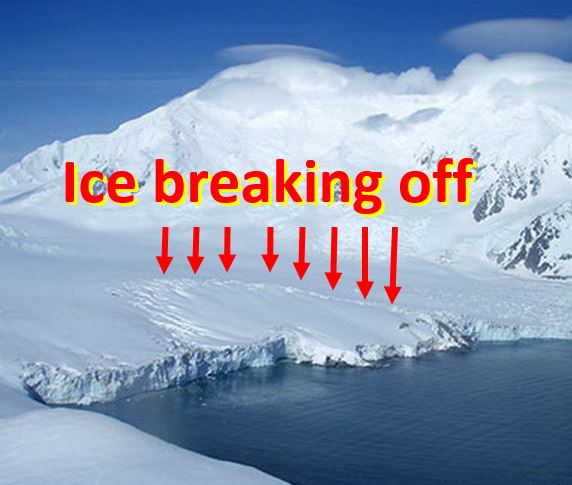There has been a sudden increase in a previously stable part of Antarctica – the Southern Antarctic Peninsula – say scientists from the UK, Germany, France and the Netherlands. The region had shown no signs of change until 2009.
The researchers, led by the University of Bristol, used measurements of the elevation of the Antarctic ice sheet made by a series of satellites.
From 2009, they found that several glaciers along a vast coastal expanse of the region, measuring about 750 kilometers (466 miles) in length, suddenly began to shed ice into the ocean at an almost constant rate of 60 cubic km, or around 55 trillion litres of water, annually.
 A glacier system on Livingstone Island near the Antarctic Peninsula. You can see ice being discharged into the sea. (Image Credit: Alba Martin-Español)
A glacier system on Livingstone Island near the Antarctic Peninsula. You can see ice being discharged into the sea. (Image Credit: Alba Martin-Español)
The research team wrote about their findings in the academic journal Science.
This ice loss, which shows no sign of waning, is the second biggest contributor to the sea level rise in Antarctica.
Study leader, Dr. Bert Wouters, a Marie Curie Fellow at the University of Bristol, said:
“To date, the glaciers added roughly 300 cubic km of water to the ocean. That’s the equivalent of the volume of nearly 350,000 Empire State Buildings combined.”
The scientists used data from observations by the CryoSat-2 satellite, a mission of the ESA (European Space Agency) dedicated to remote-sensing of ice.
The satellite sends a radar pulse (from 700 kilometers away) to Earth, which is reflected by the ice and subsequently bounced back to the satellite.
The ice is thinning
By measuring how long the pulse takes to bounce back, it is possible to gauge the elevation of the ice surface with incredible precision.
After gathering and analyzing data over a five-year period, the scientists found that the ice surface of a number of the glaciers is going down by up to 4 metres annually.
The ice loss in the Southern Antarctic Peninsula is so extensive that it has caused slight changes in the Earth’s gravity field, which can be detected with the Gravity Recovery and Climate Experiment (GRACE), another satellite mission.
Dr. Wouters explained:
“The fact that so many glaciers in such a large region suddenly started to lose ice came as a surprise to us. It shows a very fast response of the ice sheet: in just a few years the dynamic regime completely shifted.”
The changes cannot be explained by alterations in air temperature or snowfall, according to data from an Antarctic climate model, the authors said.
Several of the glaciers in the area feed into ice shelves that float on the surface of the ocean. They act as a buffer to the ice stuck to bedrock inland, slowing down the flow of the glaciers into the sea.
Westerly winds have strengthened
In response to ozone depletion and climate warming, the westerly winds that encircle Antarctica have intensified in recent decades.
The high wind speeds push the warmer waters from the Southern Ocean toward the South Pole, where they eat away at the glaciers and floating ice shelves from below.
Over the past two decades, the ice shelves in the region have lost nearly one-fifth of their thickness, which in turn has reduced the resisting force on the glaciers.
The scientists expressed concern at the inland ice which is grounded on bedrock – much of this ice is below sea level. This means that even if the glaciers retreat, the warm sea water will flow inland and melt them.
Dr Wouters said:
“It appears that sometime around 2009, the ice shelf thinning and the subsurface melting of the glaciers passed a critical threshold which triggered the sudden ice loss. However, compared to other regions in Antarctica, the Southern Peninsula is rather understudied, exactly because it did not show any changes in the past, ironically.”
“To pinpoint the cause of the changes, more data need to be collected. A detailed knowledge of the geometry of the local ice shelves, the ocean floor topography, ice sheet thickness and glacier flow speeds are crucial to tell how much longer the thinning will continue.”
Citation: “Dynamic thinning of glaciers on the Southern Antarctic Peninsula,” Bert Wouters, Alba Martin-Español, Veit Helm, Thomas Flament, Melchior van Wessem, Stefan Ligtenberg, Michiel van den Broeke and Jonathan Bamber. Science. Published 21 May, 2015. DOI: 10.1126/science.aaa5727.
Video – Antarctic Ice Loss

